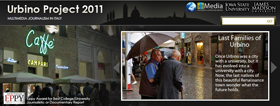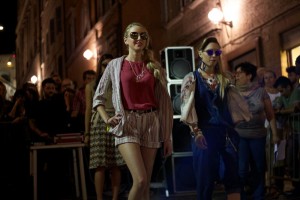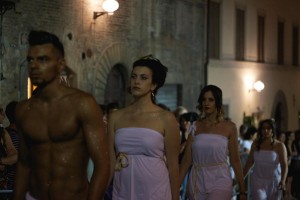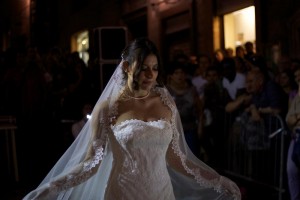Urbino’s Fashion Night Out - Urbino Project 2015

- Devon Jefferson
- On June 24, 2015
An inside look at Urbino’s premier fashion show, the Sfilata Sotto Le Stelle.
The runway stretches into the distance down the rustic brick of Via Mazzini. A warm evening light creeps in from the arched entry at the foot of the street. Lights, photographers, and posing marks for models adorn the catwalk. Railings on either side of the runway carpet split the catwalk from the hundreds of people slowly crowding in to watch.
Next to the top of the runway, a Renaissance-era courtyard now functions as an impromptu dressing room. Models run in and out for styling, hair and make-up, and final choreography before walking the walk. Outside the courtyard, at the top of the carpet, a DJ sits in the center of the chaos, flanked by two towering speakers that billow music at an energetically deafening level. Children dance beside their families and look on with excitement in their eyes for what’s to come.
“We are almost ready to begin,” the announcer says at a quarter to 10.
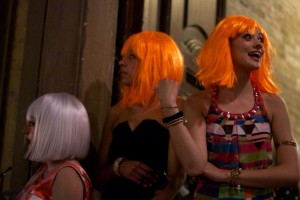
Models await their turn to start down the catwalk at Urbino’s Sfiliata Sotto Le Stelle–Parade Under the Stars.
This evening looks and feels like something out of Marie Claire or a Mercedes Benz Fashion Week event. But this isn’t Florence, Milan, or Rome. This extravagant night is the brainchild of the boutique owners, designers, and retailers of Urbino, Italy, who have turned an unlikely stretch of Via Mazzini into the perfect setting for a charming fashion night out. What started as a strategic move to drum up business and promotion has turned into a collaborative creative effort, says Stefani Palazzi, owner of Nashville Boutique and an organizer of the event.
“We do this because we feel it can represent the fashion culture in Urbino—we want to try to do our best to make this event very successful,” says Palazzi.
For centuries, Italian fashion has been among the most revered in all of Europe. As early as the 11th century, powerful cities like Venice, Milan, Florence, and Naples produced some of the finest textiles, jewelry, shoes, robes, accessories, and elaborate dress of Europe. At the peak of the Renaissance, Italian fashion became known for its extravagance — velvets, brocades, ribbons, jewels, and fine detail.
However, by the 17th century, Italian fashion was dethroned, and didn’t begin to regain popularity until the 1950s, around the time Giovanni Battista Giorgini, an Italian businessman, began hosting aristocratic soirees and fashion shows. At the most famous of these soirees, “The First Italian High Fashion Show,” held February 12, 1951, several famous designers, like Fabiani, Simonetta, and the Fontana sisters, presented collections at Giorgini’s Florentine residence. The show attracted the attention of international buyers visiting from the Parisian Haute Couture shows. Soon, designers and boutiques across the region began mass-producing the Italian collections and exporting them to foreign markets — thus kick-starting the prêt-à-porter (ready-to-wear) era in Italian fashion, setting Florence as the birthplace of modern fashion in Italy, and revitalizing the market for the country.
Now, 60 years later and 185 kilometers away, in this walled city of the Le Marche region, designers, boutique owners, and entrepreneurs alike are applying the tactics of innovators like Giorgini to market their ready-to-wear business model to the public. The Sfilata Sotto Le Stelle (Parade Under The Stars) fashion show on Via Mazzini is a highlight of the series of Friday night events called Serate Ducali (Duke’s Nights) that are reminiscent of Giorgini’s soirees. Taking place from early June through the beginning of July, the events are planned by the Associazione Commercianti di Urbino.
The association was started around 10 years ago in an effort to cultivate a partnership between the many shop owners of the city and bring more business to the historic center of the town. The organization now works year-round planning events for winter holidays and the summer months that showcase the products and services the shops provide. At the heart of the association’s efforts are the Serate Ducali events. This year, the third year of the celebration, Serate Ducali now offers six different evening events, including the fashion show on Via Mazzini, street art nights, evening dancing, and live performances.
Marco Lazzari, president of the Associazione Commercianti di Urbino, says that when they created the Serate Ducali events, the idea was to have different nights with varying forms of entertainment in the historic center of the city.
“The goal of these events is to make Urbino come alive in the historic center,” says Lazzari.
Each lively event requires months of strategic planning. These kinds of bureaucratic duties are a large part of the event planning process and what the association does as a whole, Lazzari says.
“The association is voluntary; everyone pays a bit of money each year so that we can organize the events, like Serate Ducali. Politics are not involved in these events but we want to engage the administrations here in Urbino,” Lazzari says.
Lazzari works with a four-person team primarily focused on requesting city authorizations needed for events like the fashion show. He also works closely with event organizers and shop owners like Valeria Violini, owner of the Vodafone store in Urbino’s Borgo Mercatale, and one of the three producers in charge of the fashion show. The Sfilata Sotto Le Stelle was first held a year ago when Violini and a few other shop owners hatched the idea for the fashion show as a part of Serate Ducali.
“Our reason for doing this is to make the town more lively and offer something different to the public, but also respecting the rules in the process,” says Violini.
Now, the Sfilata Sotto Le Stelle fashion show features over a dozen retailers and designers of the region all jammed into an action-filled one-hour runway show. Around 6,000 euros and a prodigious catalog of models are only a few of the essential pieces to make this event happen.
In preparation for this year’s show, Violini and the other producers started contacting boutique owners and designers in the region to provide accessories, clothing collections, jewelry, and other merchandise to be showcased. The organizers of the event met with the association once a week for six months to trade ideas and collectively come up with a formula for the event that best fit everyone’s needs. From there, they cast models and divided them among each boutique. The models were then split up based on categories such as cosmetics, accessories, and other styling details. Then Violini decided on the order of the show. After the models were cast and grouped, the organizers hired a choreographer and had two rehearsals before the event. Violini describes the planning process as a multi-layered undertaking that involves bureaucratic duties, civil responsibility, and creativity all at once.
“The fashion show is a way to give exposure to the stores. It’s a good way for them to get publicity and also give alternative entertainment to citizens, both students and old people,” Violini says.
All the planning lead up to this: One hour before showtime, workers roll the carpet down Via Mazzini. More than a dozen models are in Mazzini Parrucchiere salon being styled by young cosmetologists and the owner, Stefano Iacomucci. The models are all covered with a layer of shimmering golden glitter dust and clad with flowing white gowns, inspired by historic Roman dress designs. Their hair is keenly styled in high buns and up-dos accented by fresh olive branches and leaves. The men are a bronze golden tint from their spray tans—each of them shirtless and wearing revealing white cloths gathered at the waist by a single golden rope. Iacomucci says that he is very inspired by history and wanted to modernize a classic dress practice to offer something different.
It’s now 10 p.m. and on the runway are models representing Palazzi’s Nashville Boutique, wearing glowing neon orange-and-white wigs. A brunette with a bun saunters out of the courtyard in an elegant white trench-style overcoat paired with designer slippers. Following her is a short, petite young woman wearing a shining orange wig and a black romper-style jumpsuit with a low pointed heel.
Palazzi styled the models in pairs to offer a unique presentation on the catwalk. Together the looks compare and contrast each other giving the boutique a well-rounded offering. Palazzi’s vast knowledge of trends and ready-to-wear markets are the product of years working in retail; she now owns the same boutique where she started working 34 years ago. She is precise in the way the models are styled with garments that are either in-season or trending, mixed with classic staples, giving her collection a fashion-forward feel.
Palazzi’s models line up at the end of the runway to make their exit. Standing together, the breadth of styles they cover is staggering: business casual, street chic, evening wear and seasonal dresses that incorporate almost every Pantone color and in-season silhouette.
Many more boutiques hit the runway as the night goes on; what was supposed to be a one-hour event has turned into a full-blown runway show. There are so many different styles: classic, modern street-wear, sportcore. Each shop shows their newest collections and designer items like Gucci and Marc Jacobs. The attention to details and accessories like scarfs, jewelry, and styling speaks to this region’s precise fashion interests.
It’s 11:30 now and the mood changes. The streetlights cast a soft, romantic glow on Via Mazzini. The music slows to a powerful ballad, and out glides a woman with a slicked-back ponytail in a white, halter-collar gown. The model is with five children: four little girls with matching white dresses and flower-bedecked pigtails and one boy with parted hair in a three-piece suit. The girls skip and throws flowers as the boy holds the woman’s hand and walks her down the runway.
This is the finale of the show with the Atelier Cardelli bridal shop taking the stage. Vinicio Cardelli, now lead designer of the shop, was born in Urbino and studied here before he went to work with his family in Acqualagna. Atelier Cardelli has operated for over 70 years. Cardelli says that their gowns are designed with classic details, seeking to fulfill the buyer’s needs.
“We don’t just sell clothes; we sell dreams. The woman who buys the dress doesn’t want the dress [itself]; she is dreaming of something, so we try to give them that dream,” Cardelli says.
Now, a brunette paces onto the runway with an up-do adorned by two large curls that frame her face and lead the eye down the length of her veil. She is wearing a white velvet-and-lace mermaid-style gown. Her hands trace the outline of the dress and she beams widely, as if she is dreaming of her own wedding as she walks. Lace detail sprawls all over the dress and adds an accent on the veil. She has on a small pearl necklace and white gloves. Behind her is a couple, a man in a black Tuxedo with a wing-collar dress shirt and a woman with a gleaming ball gown studded with jewels and complex embroidery patterns.
Cardelli says that he likes to have drama and action in his shows and wants the ending to always be shocking or exciting. He and his three sisters put this elegant grand finale together, something their family often does.
“I love everything about my job but I really like doing fashion shows because if you don’t show what you create it doesn’t mean anything, and that’s why I like to do these shows because you need to show people what we can do,” Cardelli says.
Adele’s “Someone Like You,” starts playing, and the last of the models file out onto the runway. All of them, about a dozen, from the Atelier Cardelli show are lined up side-by-side, taking up the entirety of the runway. Women begin to make their way to the railing on either side of the runway with a look of desire in their eyes.
“Never mind—I’ll find someone like you,” Adele sings from the speakers as the music roars into the night.
The announcer hands each model a rose, and, on cue, they all throw their roses into the air. In that split second, hundreds and hundreds of hands reach up into the sky toward the stars, and everyone erupts into applause for the Sfilata Sotto Le Stelle fashion show.
Slideshow
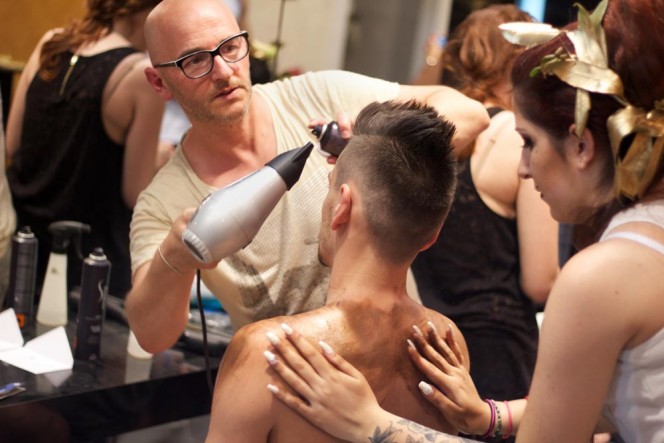
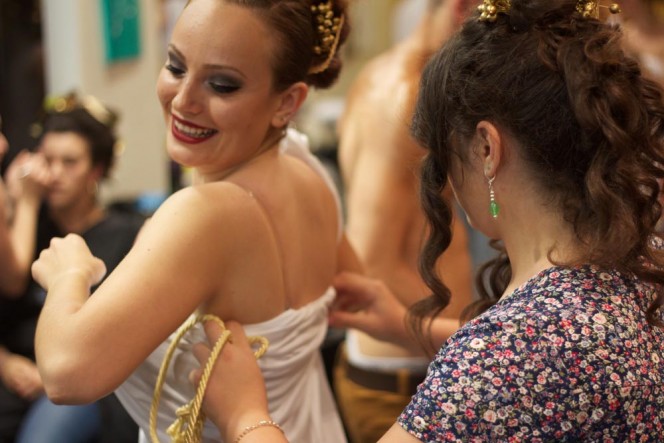
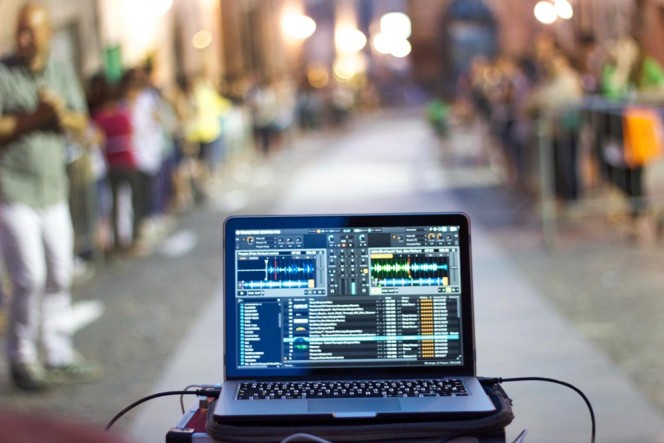
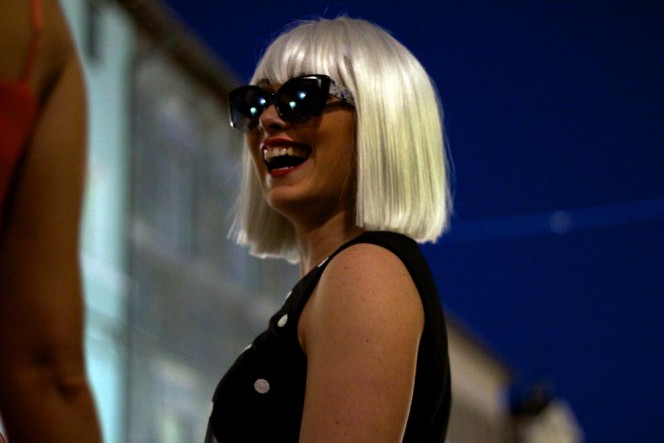
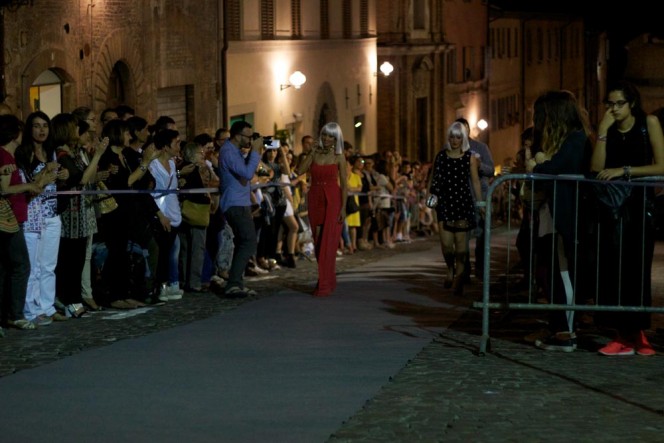
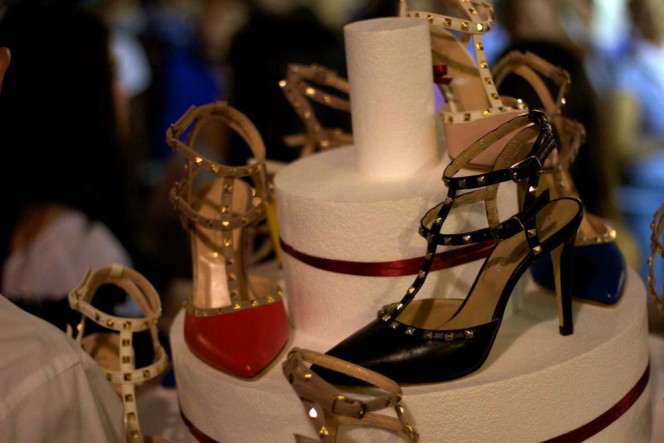
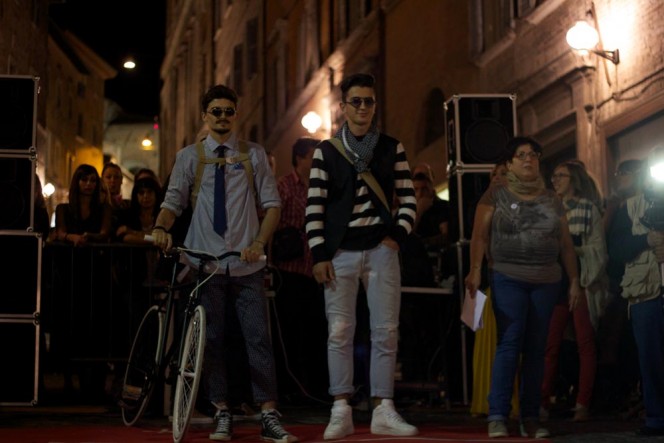
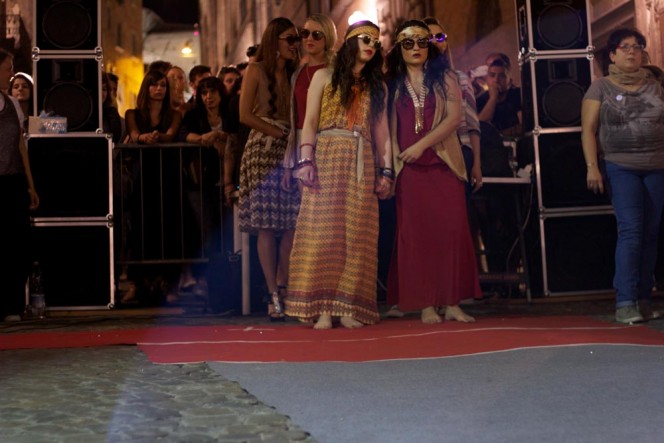
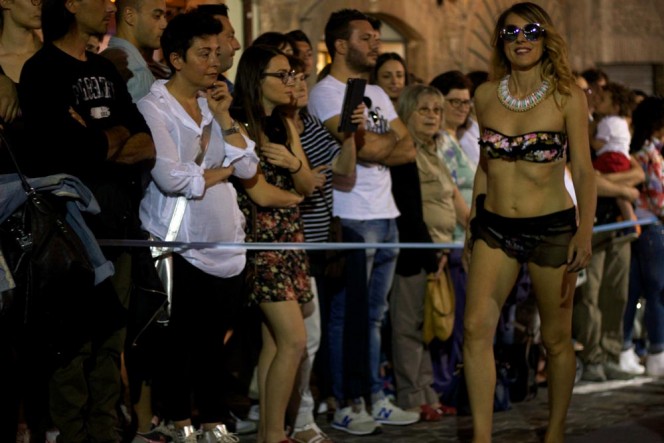
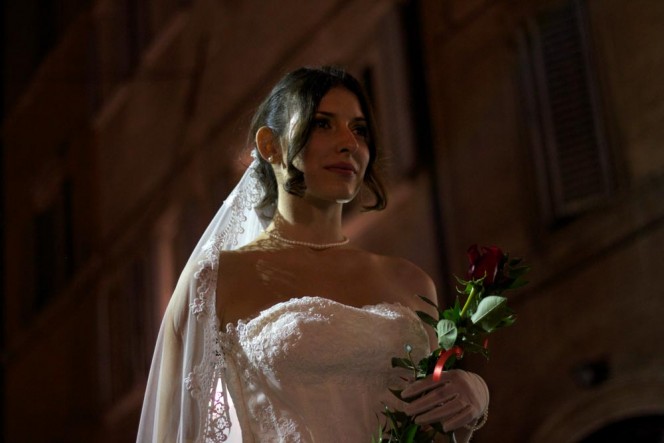
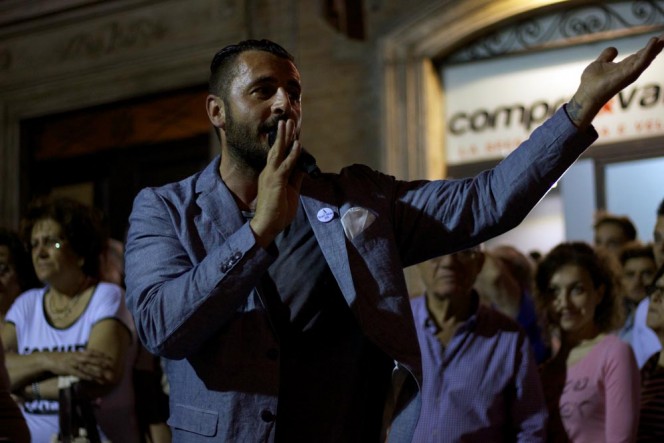
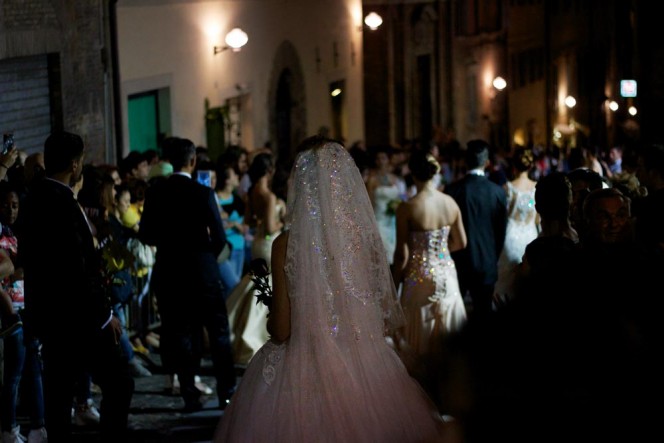
This article also appears in Urbino Now magazine’s Urbino Centro section. You can read all the magazine articles in print by ordering a copy from MagCloud.
Order Urbino Now Magazine 2015
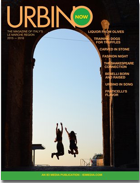 You can read many articles appearing on this website in Urbino Now Magazine 2015. To order a full-color, printed edition, please visit MagCloud.
You can read many articles appearing on this website in Urbino Now Magazine 2015. To order a full-color, printed edition, please visit MagCloud.Reporters
Courtney Bochicchio
Christina Botticchio
Deanna Brigandi
Alysia Burdi
Anita Chomenko
Isabella Ciano
Rachel Dale
Caroline Davis
Nathaniel Delehoy
Brittany Dierken
Sarah Eames
Thomas Fitzpatrick
Kendall Gilman
Michele Goad
Julianna Graham
Yusuf Ince
Devon Jefferson
Rachel Killmeyer
Kaitlin Kling
Abbie Latterell
Ashley Manske
Rachel Mendelson
Alyssa Mursch
Manuel Orbegozo
Dylan Orth
Olivia Parker
Katie Potter
Gerardo Simonetto
Jake Troy
Stephanie Smith
Tessa Yannone
Ryan Young
Promotional Video Project
Nicole Barattino
Richard Bozek
Rebecca Malzahn
Abigail Moore
Charlie Phillips
Story Categories
Past Urbino Projects
 Read stories and view the photography and video from last year's website.
Read stories and view the photography and video from last year's website.
2013 Website
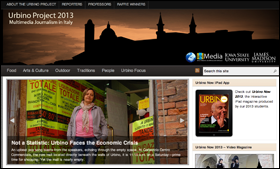 Read stories and view the photography and video from the 2013 website.
Read stories and view the photography and video from the 2013 website.
2013 Urbino Now App
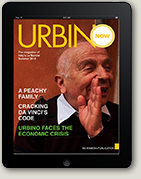 Interactive Apple iPad app covering culture and travel for visitors to Urbino and Le Marche.
Interactive Apple iPad app covering culture and travel for visitors to Urbino and Le Marche.
2012 Website
 Read stories and view the photography and video from the 2012 website.
Read stories and view the photography and video from the 2012 website.
2012 Urbino Now Magazine
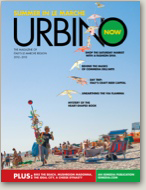 Explore past coverage from the 2012 edition.
Read all 30 magazine articles online or visit MagCloud to order a printed copy of Urbino Now 2012.
Explore past coverage from the 2012 edition.
Read all 30 magazine articles online or visit MagCloud to order a printed copy of Urbino Now 2012.
2011 Website
